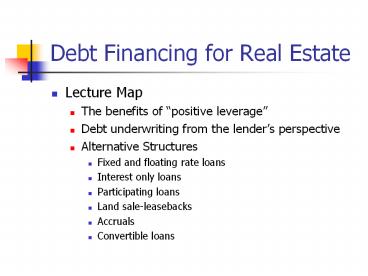Debt Financing for Real Estate
1 / 12
Title:
Debt Financing for Real Estate
Description:
... of land value, vs. LTV if included in typical loan calculation ... Negative amortization situation. An ARM with a payment cap is effectively an accrual loan ... – PowerPoint PPT presentation
Number of Views:208
Avg rating:3.0/5.0
Title: Debt Financing for Real Estate
1
Debt Financing for Real Estate
- Lecture Map
- The benefits of positive leverage
- Debt underwriting from the lenders perspective
- Alternative Structures
- Fixed and floating rate loans
- Interest only loans
- Participating loans
- Land sale-leasebacks
- Accruals
- Convertible loans
2
Positive Leverage
- Benefits of borrowing
- Decreasing equity exposure to the asset
- Tax deductibility of interest expense
- Positive leverage
- Before and after tax returns to equity are
greater with than without debt - As long as debt costs less than equity, it takes
less than its proportionate share of cash flow - Annual cash flow and PV of cash flow
3
Positive Leverage
- From an IRR perspective
- As long as the unlevered BTIRR gt effective cost
of debt, leverage is positive - I.e., as long as theres a positive spread
between the WACC as represented by cap and
discount rates, and the interest cost of debt - Even if the unlevered ATIRR lteffective cost of
debt, leverage can still be favorable because of
the tax deductibility of the interest
4
Underwriting from the Lenders Perspective
- Steps in Lender analysis
- Market study
- Appraisal
- Analysis of borrower financial condition
- Financial analysis of asset
- Loan to value
- DCR test
5
Setting the Loan Terms
- Determination of Loan Amount
- Based on ratio tests, risk assessment
- Other provisions designed to address risk
- Prepayment provisions
- Reps and warranties
- Loan covenants
6
Alternative Loan Structures
- Loan Structures reflect a trade off of risk and
return between the parties - Lender evaluates looser underwriting conditions
for greater return - Borrower evaluates more or less debt proceeds
versus - Timing of cash flows
- Cost of incremental debt vs. outside equity
7
Fixed, Floating and Interest Only Loans
- Fixed rate loans are the standard
- Floating rate loans
- Construction and mini-perms
- Acquisition lines of credit
- Interest only loans
- balloon or bullet payment at maturity
- Used for
- Construction
- Acquisition lines of credit
- Structured finance transactions
8
Participating Loans
- Lender trades risk for higher potential returns
- Reduces LTV, DCR coverage
- ? Increases loan amount
- Takes a percentage of after debt service cash
flows - Structured as additional interest
- Total of fixed payment and percentage interest
creates higher total yield on loan dollars
invested
9
More on Participating Loans
- Borrower benefits
- Greater loan proceeds
- Often cheaper than equity which might have to be
raised from outside sources - Lower fixed debt payments
- Less pressure on short term NOI
- Borrowers decision
- What is the incremental cost of borrowing the
extra loan amount, vs. cost of equity? - If the deal IRR is weighted toward the residual,
the lenders participation in the residual is
probably less than an equity investors would be
10
More Alternatives
- Land Sale Leaseback
- Financing land separately from improvements
- Higher total loan proceeds
- Finances 100 of land value, vs. LTV if included
in typical loan calculation - 100 of payments are tax deductible
- Vs. only interest portion if financed by loan
- Risk is in subordination provision
11
More Alternatives (cont.)
- Accrual Loans
- Pay rate lt stated interest rate
- Negative amortization situation
- An ARM with a payment cap is effectively an
accrual loan - Tax benefits
- Creates greater tax shield ? deductible interest
is based on the accrued rate, not the pay rate - More risk to the lender ? WHY?
12
One More.
- Convertible Loans
- Lender has an option to convert ie, swap loan
proceeds for partial equity ownership - Would convert if the equity value of the interest
exceeds the mortgage balance at conversion date - Borrower benefits
- Lower interest rate, greater current cash flow in
exchange for potential loss of equity value in
the future































